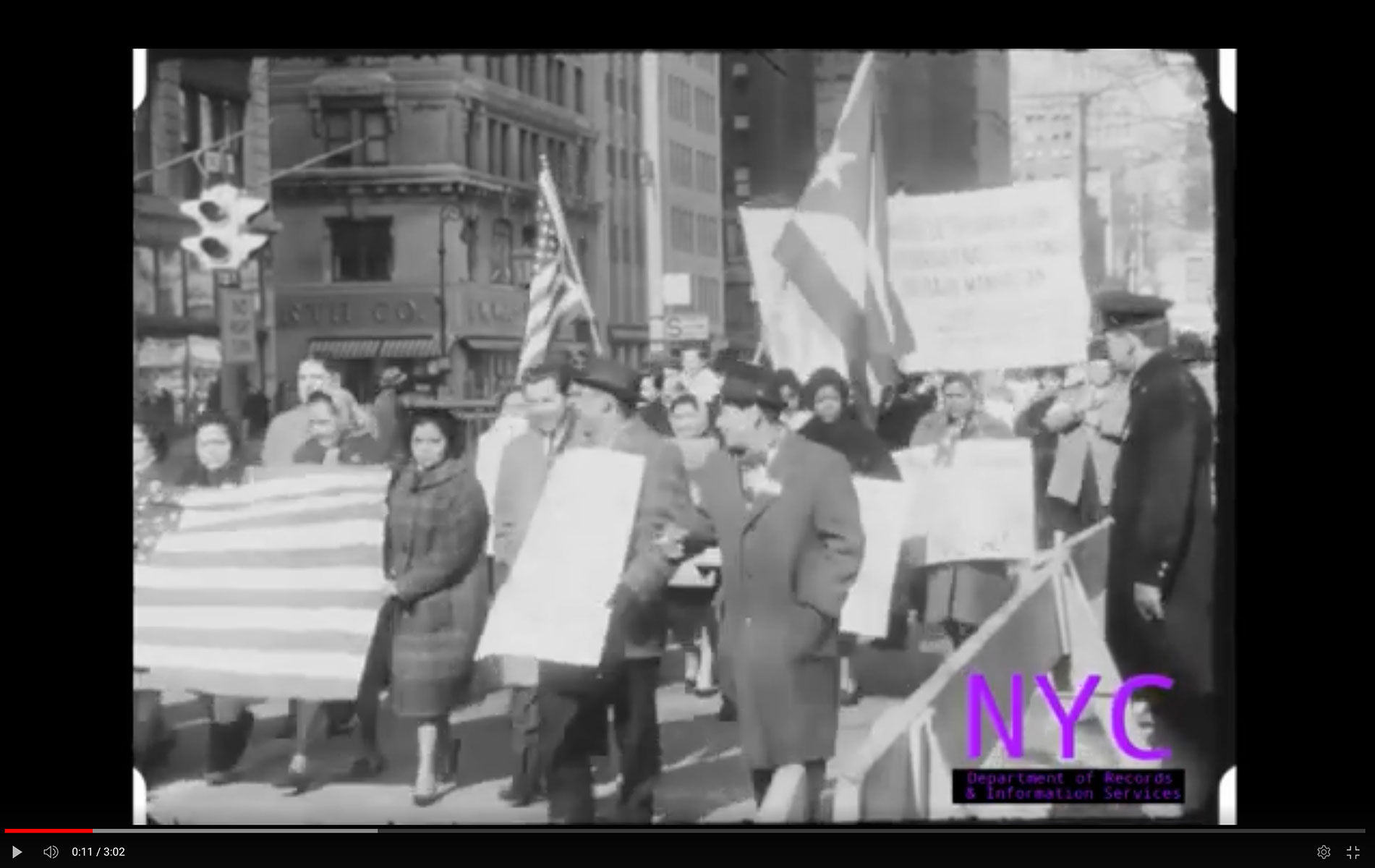Puerto Rican Civil Rights March on Film

Date: Mar 1, 1964
Caption: A film recorded by the New York Police Department showing the Puerto Rican Civil Rights march on March 1, 1964. Puerto Rican community organizations were joined by others who were in solidarity with them marching at City Hall.
Concern about school segregation was not only expressed during the school boycott. On March 1, 1964, Puerto Rican community organizations held a civil rights march in front of City Hall. They were joined by a range of other organizations, including the New York Urban League and the Jamaica NAACP, and representatives of several labor unions including District 65 of the AFL-CIO and SEIU local 1199. Based on the content of marcher’s signs, segregation in education was a major concern for the marchers.1
Signs read:
- Mejor educación para los niños puertorriqueños
- Separate but equal doesn’t work
- Integración es un gran educación
- Better education means better jobs means better lives
- Quality integrated education now
- Combata por mejor educación y derechos civiles para todos
- We demand the teaching of Puerto Rican history
- Jim Crow no enseña democracia
- Mejor education significa mejor trabajos para vivir
This footage gives us a glimpse of one march led by Puerto Ricans and participated in by Black and white New Yorkers. But the footage was not created for us. According to the New York City Municipal Archives, this footage was recorded as part of the New York City Police Department’s surveillance program: “Throughout the 20th century, the New York City Police Department (NYPD) conducted overt [or visible] and covert [or hidden] surveillance on groups and individuals identified as potential security threats to the City… The subjects include a broad range of political activist groups and events from 1960 to 1980.” 2 That “broad range” includes many activists of color who were challenging racism and other kinds of injustice. The NYPD filmed protests against police brutality, against the Vietnam War, against racism in hiring construction workers, and more. Based on their decision to send the surveillance film team to this march, we can see that the police perceived the marchers as “potential security threats.” That is one example of how Black and Latinx people, and those white people in solidarity with them, have been “criminalized” - or understood as criminals - in the US.3
-
For more on Puerto Rican organizing in New York City, see Sonya Song-Ha Lee, Building a Latino Civil Rights Movement: Puerto Ricans, African Americans, and the Struggle for Racial Justice in New York City (Chapel Hill: University of North Carolina Press, 2016) and Lorrin Thomas, Puerto Rican Citizen: History and Political Identity in 20th Century New York City (Chicago: University of Chicago Press, 2010). ↩︎
-
NYPD Surveillance Films, NYC Municipal Archives Collection, New York City Departments of Records and Information Services, accessed February 7, 2023, https://nycma.lunaimaging.com/luna/servlet/NYCMA
33. ↩︎ -
Elizabeth Hinton, From the War on Poverty to the War on Crime: The Making of Mass Incarceration in America (Cambridge, MA: Harvard University Press, 2016). ↩︎
Categories: parent activism, student activism, K-12 organizing, Manhattan
Tags: policing and the criminal legal system, protest, racist segregation, organizing, curriculum, labor unions, Latinx people, multiracial organizing, employment, photography, imagery, and visual representation, Spanish language
This item is part of "The 1964 Boycotts" in "Boycotting New York’s Segregated Schools"
Item Details
Date: Mar 1, 1964
Creator: New York Police Department Surveillance Unit
Source: Municipal Archives of the City of New York, NYPD Surveillance Films
Copyright: Under copyright. Used with permission. Courtesy of the Municipal Archives, City of New York
How to cite: “Puerto Rican Civil Rights March on Film,” New York Police Department Surveillance Unit, in New York City Civil Rights History Project, Accessed: [Month Day, Year], https://nyccivilrightshistory.org/gallery/puerto-rican-civil-rights-march.
Questions to Consider
- Why do you think the protesters marched behind the US and Puerto Rican flags? What were they hoping to communicate?
- Why do you think that the marching organizations included Puerto Rican organizations, Black organizations, and labor unions, among others? What linked these organizations together?
- What difference does it make, to you as a viewer, to know that this footage was recorded by the New York Police Department? How does that affect what we can learn from it? How do you think the participating students and adults would have felt, if they knew they were being recorded by the police?
References
How to Print this Page
- Press Ctrl + P or Cmd + P to open the print dialogue window.
- Under settings, choose "display headers and footers" if you want to print page numbers and the web address.
- Embedded PDF files will not print as part of the page. For best printing results, download the PDF and print from Adobe Reader or Preview.
